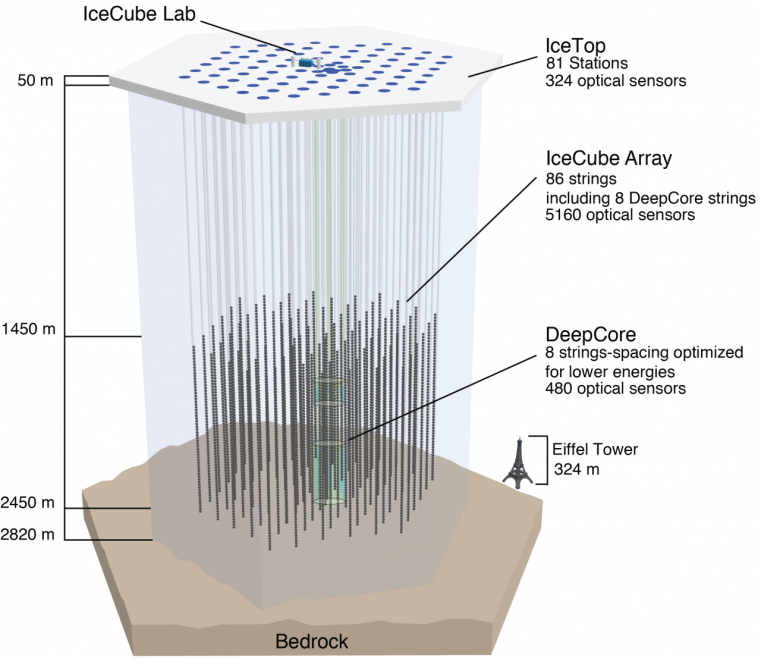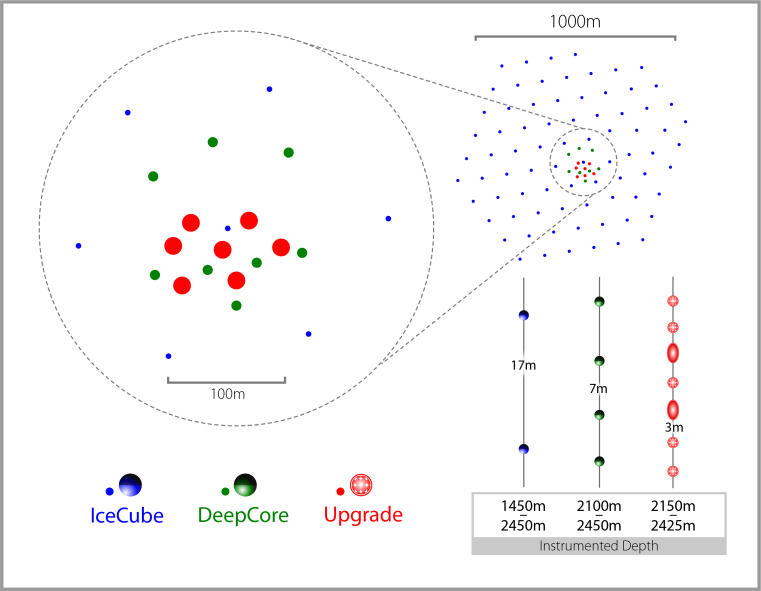IceCube Neutrino Observatory

IceCube is an international collaboration that operates the eponymous and currently largest neutrino telescope in the world. The main task is the discovery and investigation of galactic and extragalactic sources of high-energy cosmic neutrinos. In addition, the detector has also proven to be an excellent instrument for searching for dark matter (WIMPs), precise measurement of oscillations of atmospheric neutrinos, and the investigation of other current questions in particle and astroparticle physics. With the surface detector IceTop, the spectrum and composition of cosmic radiation can also be measured in the energy range of the so-called knee at 1015 eV.
The neutrino detector consists of 86 strings, each equipped with 60 optical sensors (photomultipliers), which instrument a volume of 1 km3 of clear ice at depths between 1500 m and 2500 m at the geographic South Pole. Neutrinos are reconstructed indirectly via the Cherenkov light emitted by charged secondary particles (e.g., electrons and muons) that are produced in neutrino interactions. Further information about the detector, its functioning, and the physics investigated can be found on the IceCube homepage.
Two expansions are planned for the detector, the IceCube Upgrade (Homepage) and IceCube-Gen2 (Homepage).
Our group is engaged in analyzing the data from the detector, especially with regard to the search for dark matter. In addition, our group is leading the hardware developments for the optical sensors. We are also working on simulations of the optical sensors to investigate their properties in more detail and to compare them with measurements.
IceCube Upgrade

To improve the efficiency of the detector for low energies from 1 GeV, IceCube is being expanded by 7 strings with a total of 693 optical sensors. The strings will be installed in the central part of the IceCube detector at a depth of 2150m to 2425m in a dense configuration, as low-energy events generate only a small amount of Cherenkov light. Two newly developed optical sensors are used: the multi-PMT Optical Module (mDOM) and the D-Egg sensor, which consists of two PMTs. In total, 402 mDOMs and 277 D-Eggs will be embedded in the ice. Central topics that will be investigated with the IceCube Upgrade are the oscillations of atmospheric neutrinos and the unitarity of the PMNS matrix.
Our working group is involved in the design, testing, simulation, and production of the mDOMs. The mDOM consists of a total of 24 3" PMTs and offers a larger effective sensor area as well as a better directional resolution than the previous IceCube DOM.
IceCube-Gen2

In contrast to the IceCube Upgrade, IceCube-Gen2 aims to improve IceCube's performance at high energies. Following the initial discovery of high-energy cosmic neutrinos with the IceCube detector in 2013, a next-generation neutrino telescope at the South Pole, IceCube-Gen2 (Homepage), is now in the planning phase. The detector will be expanded by three components, namely the In-Ice Optical Array (orange), the Surface Air Shower Array, and the Extended Radio Detector Array (purple). The In-Ice Optical Array will encircle the current IceCube detector (blue) with about 120 additional strings, each equipped with up to 80 optical sensors. In total, this will instrument a volume of 8 km3. The main task is the exploration of the high-energy universe.
Our group is involved in the design of the main sensor for the In-Ice Optical Array, LOM. LOM stands for eLongated Optical Module and combines the advantages of the two optical modules from the IceCube Upgrade, mDOM and D-Egg.
